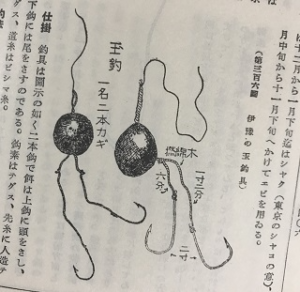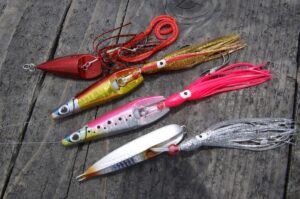Fishing for Kue, the King of Iso
The goliath grouper is the big entertainment on YouTube. But Japan has monster groupers, too. One of the most prestigious targets is a fish called Kue (Longtooth grouper, Epinephelus bruneus).
There are several ways to catch Kue. Iso (rocky coast) fishing (cast-and-wait style, called Sokomono fishing) and offshore boat fishing.
Since the uniqueness of the fishing, in this article, I will introduce the Kue fishing from Iso. The significance of this fishing is to catch the big fish from the shore.

You can see the ruggedness from the tackles and the line thickness, in the picture below.

On top of it, one of the reasons why this is prestigious is the taste and rarity of it. As some of you may know, balloon fish is famous for its delicacies in Japanese cuisine. Some people, who have tasted Kue, say that the meat of Kue is much better than that of balloon fish. Since eating fish is a very important factor of fishing in Japan, it is convincing that this Kue is one of admirable target fish for anglers. Additionally, because it is hard to get this fish on a commercial fishing basis, only anglers can enjoy this fish. (Note; fortunately, the artificial reproduction method is beginning to be operable. And Kue may be more accessible.) This rarity is also bringing the fish to a higher level as an angling target.
For Kue as a sushi, please refer to this link.
For other dishes, please refer to this link.
Species and distribution
Kue (Longtooth grouper, Epinephelus bruneus) is living in the Western Pacific Ocean, along the coast of western Japan, southern coast of South Korea, and shores of China and Taiwan. In Japan there are some fish in the north eastern areas, but the famous areas are such as Kyushu Island, Shikoku Island, Wakayama and Izu Islands.

As one of the grouper species, it is under the same genus as goliath grouper (Atlantic Goliath Grouper, Epinephelus Itajara, (Genus Epinephelus). In this genus, the biggest species such as Goliath grouper grows over 2.5 m, 360 kg, and our Kue grows up to 1.4 m, with weight of 33 kg. It is said that the growing speed of Kue is slow. It takes more than 20 years to reach 1 m. It becomes 15 cm in its first year, and requires 5 years to become 50 cm. As there are fish of over 1 m, you can see that these fish can live as long as 30 to 40 years. Average size you can catch is 60 to 80 cm.
It dwells in the rocky bottoms of the sea. Depth ranges from 20 m to 200 m. The typical area you can see Kue fish is Iso (rocky coast) like the photo below.

The steep rocks provide enough depth for the fish, at which your rigs can reach. And the coast is washed by the current, directly.
Kue’s spawning season is between June and August. Eggs are laid near the shore, and newborns can be seen in the tidepool. As it grows, it moves to deeper areas. They form no school, and the adult individual is living alone.
Most of the time, it hides under the structures, except searching for the game during the night. At night, it swims around to search for food, such as fish, crustaceans and squids.
Fishing for Kue
You can fish for it with a cast-and-wait style. Since it involves casting and rocky coast requires a certain distance to the water, the rod length is relatively longer, 4.8 m to 5 m. As is often the case for long casting rod (like surf casting, or carp fishing,) the action is rather parabolic.

The main line is nylon no. 70 to 80 (1.40 to 1.50 mm thickness) for the standard sized fish. If you go for the bigger Kue, then the line thickness goes beyond no. 100 (1.70 mm). The reel must hold the main line of 120m or 150m. It means the sizes of Penn Senator 6/0 or 9/0, Shimano’s 50 size or Daiwa’s 60 size multiplier.
There are some people who use braided lines of no.10 to 15 (0.50 to 0.70 mm). However, as it requires extreme strength against abrasion from rocks, hard core Iso Kue angler prefers nylon to braided line. Additionally, you can expect some cushioning from nylon lines. As it does not fish in very deep areas (comparatively,) and anglers do not need to pay so much attention on the small bites, the water resistance on thick nylon lines is ignorable with its strength advantage.
From the end of the main line, it connects the wire #32 to #41 to the crane swivel. The hook leader is also wire #32 to #41. The other side of the crane swivel has the sinker leader, of nylon material, and it connects to the sinker of 30 to 40 gou (110 g to 150 g. It uses a heavier one if the current is strong.) The reason why sinker leader is nylon is that anglers can get the rig back when the sinker snags in the bottom (Note; I know it is a controversial matter, to leave the lead sinker in the bottom. Gradually steel sinker use is growing.)

There is a special shape of hook, Kue hook. The key of the hook design is the strength and the easiness to hook the bait. The weight of the hook does not matter, and it uses the very thick wire, with the eye. The point is circled, and how far it circles depends on the preference of anglers.

Bait
A whole fish is used for the bait. The popular bait fish are Amberstripe scad, Japanese Jack Mackerel, Japanese Mackerel, and Japanese sardines. If you can fish them from the rock you are standing on, then these fish can be used as a live bait. But some people say the dead bait does not make any difference in results. The key point is to put the bait on the hook, not to rotate in the water.
And when the rig is not casted away far, then chumming is very important. For chum, smaller dead fish, minced fish, fish guts or chopped fish are used.
Rod pod
While the rig is in the water, the rod is kept on the special rod pod. When you get a bite, this fish pulls the line with enormous power, and your rod and rod pod must receive the power with enough stability. Naturally, Kue anglers pay a lot of attention to it.

Image from this link.
These are fixed directly into the rocks. The pictured set is made from titanium. And you can see there is a shock absorbing spring in the front holder, and rope from the rod is fastened on the rock, too. There are several other styles also.
You can see the bite scene from the video below.
The fight
After it is hooked, it tries to go down with its full power. It is a different kind of pull from the tuna or marlin related fish, with torpedo form. They run away in a horizontal direction with its power and speed. But Kue tries to go down, with torqueful swimming power, as is often the case for the fish with higher backs. It tries to go back to the bottom to hide away below the rock. If it goes down there, then the line rubs on the edge of the rock and it breaks.
Therefore, the Kue angler needs to pull it away from the bottom as strong as possible, while saving the main line not to exceed its strength threshold.
It is a pure fight, human against fish, head to head. This is another attraction of this fishing (if you could ever win…)
In some cases, it is better to leave the rod on the rod pod to deal with the fish. You know, it has 1.50mm nylon.

History about Kue
Kue is called in different names depending on regions. It is Ara in Kyushu, Moroko in some western Japan, Masu in Aichi, Aona in Shikoku. Though it is a rare fish from a commercial point of view, and you can seldom see it in a supermarket, it must have been somehow a familiar fish while it is living near the coast.
In Karatsu, Saga prefecture, there is a festival called Karatsu Kunchi, which has begun from the Edo period. Around this festival, they often serve the cuisine with Kue (see this link for the photo of this cuisine.)
The name of this fish can be traced back to the 10th century. In the year 927, a record of laws and customs, Engishiki was completed. And it mentioned Kue as one of the food items. This record was describing the regulations for various rituals and regime operations, including the food they needed to submit (as for tax) for the emperor and for officials, to use their daily food and for special food for rituals. Kue was listed as one of the fish items. It said it was submitted by the Kii and Awa region (currently Wakayama prefecture and Tokushima prefecture, respectively.)
In this period, the Heian period, the center of the regime was located in Kyoto. It was natural to have the fish products from the neighboring cities, within 100 to 200 km distance. As we know that Wakayama and Tokushima have a lot of Iso (rocky coast) with good sea current condition, there is no doubt that Kue was supplied from these areas to Kyoto.
The way people caught the fish was, most likely, spear fishing. I imagine fishermen were diving along the Iso and spearing Kue fish. Sometimes, they might have struggled to secure the big size Kue after it is speared.
The last remark on the fish stock
As this Kue grows very slow, overfishing can easily be an issue. For this matter, we have technologies to produce or farm this fish. You can check the detailed information on this site.

